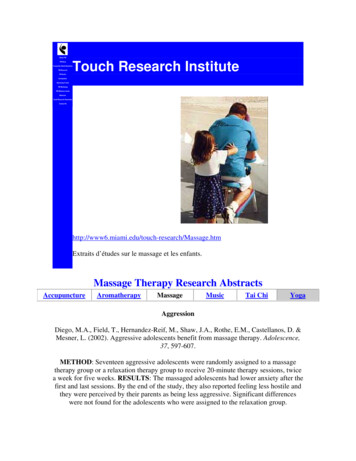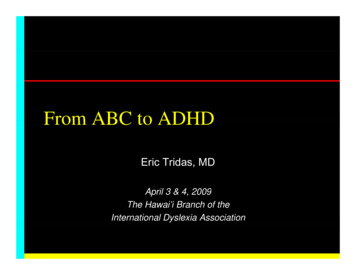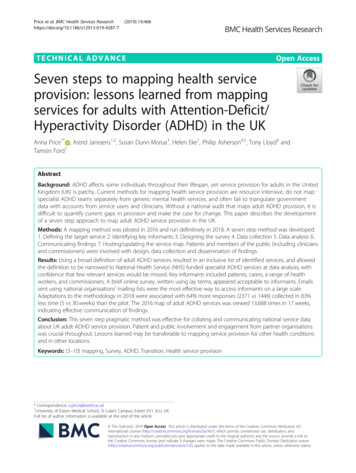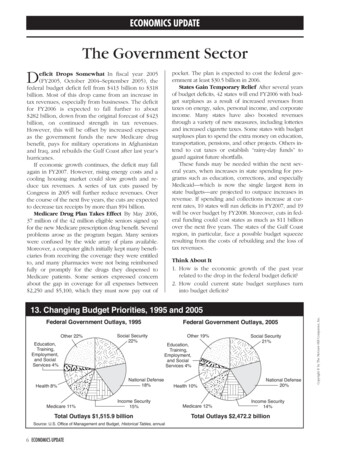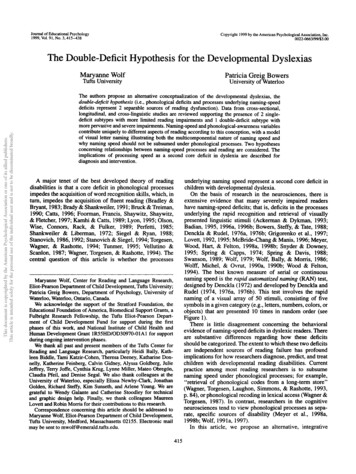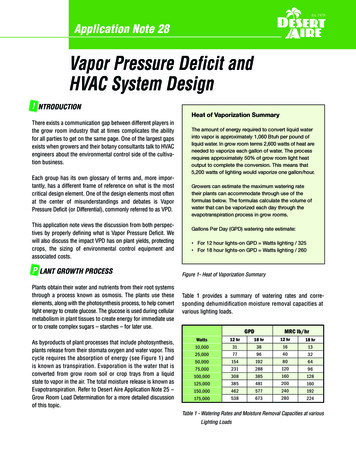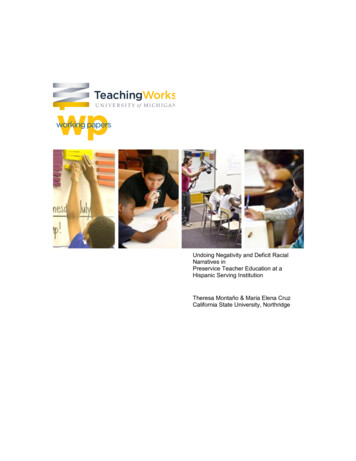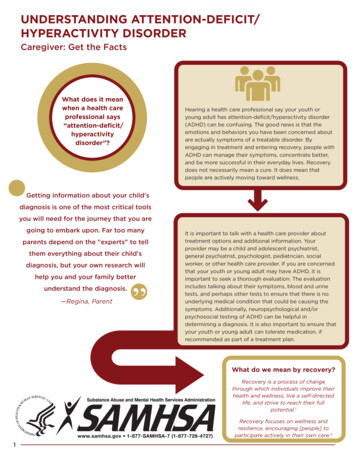
Transcription
UNDERSTANDING ATTENTION-DEFICIT/HYPERACTIVITY DISORDERCaregiver: Get the FactsWhat does it meanwhen a health careprofessional “Hearing a health care professional say your youth oryoung adult has attention-deficit/hyperactivity disorder(ADHD) can be confusing. The good news is that theemotions and behaviors you have been concerned aboutare actually symptoms of a treatable disorder. Byengaging in treatment and entering recovery, people withADHD can manage their symptoms, concentrate better,and be more successful in their everyday lives. Recoverydoes not necessarily mean a cure. It does mean thatpeople are actively moving toward wellness.Getting information about your child'sdiagnosis is one of the most critical toolsyou will need for the journey that you aregoing to embark upon. Far too manyparents depend on the "experts" to tellthem everything about their child'sdiagnosis, but your own research will“help you and your family betterunderstand the diagnosis.—Regina, ParentIt is important to talk with a health care provider abouttreatment options and additional information. Yourprovider may be a child and adolescent psychiatrist,general psychiatrist, psychologist, pediatrician, socialworker, or other health care provider. If you are concernedthat your youth or young adult may have ADHD, it isimportant to seek a thorough evaluation. The evaluationincludes talking about their symptoms, blood and urinetests, and perhaps other tests to ensure that there is nounderlying medical condition that could be causing thesymptoms. Additionally, neuropsychological and/orpsychosocial testing of ADHD can be helpful indetermining a diagnosis. It is also important to ensure thatyour youth or young adult can tolerate medication, ifrecommended as part of a treatment plan.What do we mean by recovery?Recovery is a process of changethrough which individuals improve theirhealth and wellness, live a self-directedlife, and strive to reach their fullpotential.1Recovery focuses on wellness andresilience, encouraging [people] toparticipate actively in their own care.21
What isADHD?ADHD involves a persistent pattern of inattentiveand/or hyperactive and impulsive behavior. Thesebehaviors interfere with day-to-day activities inschool, at work, or in social situations. A personwith ADHD has a hard time paying attention,following instructions, and organizing and carryingout activities. People with ADHD often lose things,are forgetful, and are easily distracted.Hyperactive behavior includes things like difficultywaiting or taking turns, fidgeting or squirming,always feeling “on the go,” and not being able tosit still. People with ADHD may interrupt others,talk excessively, and express feelings of being“driven.” The diagnosis of ADHD can be made inolder youth and adults. However, for the diagnosisof ADHD, symptoms must have appeared prior toage 12. Youth and young adults who developADHD may not be hyperactive initially. Rather,they have trouble managing behavior, payingattention, and following instructions.ADHD is typically an ongoingdisorder. In adolescence andadulthood, the hyperactivesymptoms will diminish but theorganizational and attentional challengeswill persist. However, treatments that involvemedications and other elements of anindividualized treatment program can helpyour youth or young adult improve theircoping skills (become more resilient),manage symptoms, improve everydayfunctioning, and lead a productive andmeaningful life. An individualized treatmentprogram can include positive family andpeer support or specialized educationalprogramming.What caused this?Researchers and health care professionalsdo not completely understand what causesADHD. It is unlikely that a single factorcauses ADHD. It is most likely caused by acombination of things such as genetics(i.e., family history of ADHD), chemical orother changes in the brain, and/orenvironmental factors. Traumatic experiencescan also contribute to the development ofpsychiatric disorders. If your child hasexperienced a traumatic incident, it is criticalto share that information with their mentalhealth specialist and pediatrician.Should I have known?What do we mean by resilience?Resilience is the ability to respond to stress,anxiety, trauma, crisis, or disaster. It iscritical in recovery [from mental disorders].32It is very difficult for parents and caregivers toknow if their youth or young adult havebehaviors that are consistent with ADHD.Working with trained health care professionalsis important to help assess your youth oryoung adult and to discuss how to bestapproach treatment.
ADHD can be managed in many ways. This includes theuse of behavioral therapy or a combination ofmedication and behavioral therapy. You should discusstreatment options with your youth or young adult andtheir health care provider, and make decisions based onindividual health goals and priorities. Youth or youngadults of consenting age may need to provide writtenconsent for parents or caregivers to participate on thetreatment team. It is important to talk to your child'shealth care providers about other types of treatment,such as complementary medicine, as well as programsthat can provide additional support related to education,employment, housing, and vocation and careerdevelopment. It is also important to encourage goodself-care, such as a healthy diet, exercise, sleep, andabstinence from illicit drugs. Understanding thetreatment for ADHD will help you play an active role inyour youth or young adult’s recovery.What are thetreatmentapproaches?“MedicationsMedications can help manage many of the symptoms ofADHD. Stimulant medications are the primary treatment forADHD. Each person reacts differently to these medications.For that reason, the prescribing health care professional maytry different doses and different kinds of medication beforefinding the most effective approach. Finding the bestmedication and the most effective dose may take time. Forsome people with mild symptoms of ADHD, the health careprofessional may not need to prescribe medication.I found that workingTherapyHealth care professionals may recommend behavioral therapyand parent management training as stand alone treatment orin combination with medications. Therapy may help your youthor young adult develop behaviors and daily routines that canreduce the symptoms of ADHD. It can also help you developstrategies to support your youth with ADHD.with my child’s healthcare professionals,reassuring my child theywill get better, and takingbest ways to keep ourfamily moving forward.—Jane, Parent3“care of myself were theSupportPeer and family support are also important for people withADHD. Family members and caregivers with positive attitudes,and peers who are recovering from similar disorders, can begreat assets to the team or your youth or young adult withADHD. As a partner on this team, you can help to identifyproblems early and provide important support andencouragement to help your youth or young adult comply withrecommended medications. You can also help them stayfocused on their recovery goals. Additionally, talking withother caregivers who also have a child diagnosed with ADHDcan help you to learn more and know what to expect. You maybenefit from having someone further along in the process withwhom to discuss your own questions, thoughts, and feelings.
Is this my fault?No, it is not. Decades of medical research provide evidence that ADHDand other mental disorders can be the result of a complex interactionof genetics and biological, environmental, social, physical, andemotion-al influences. None of the contributing factors alone aresufficient to cause a mental illness. Your youth or young adult is not toblame and neither are you.How common is this disorder?Data from the Centers for Disease Control and Prevention show that the rate of ADHDamong 3-17 year-olds is in the range of 6.8 percent to 8.9 percent.4How can I help?Parents, caregivers, and family members can be important partners in treatment and recovery from ADHD. Youcan play a major role by monitoring symptoms and response to medication changes and encouraging youryouth or young adult to stick with their treatment and treatment plan. It is also important to alert health careproviders if your youth or young adult uses drugs, excessive caffeine, nicotine, or alcohol. Seek immediate helpif your youth or young adult has thoughts or plans of harming themselves or others. (For more information, seethe hotline and website below*). The health care professionals and counselors working with your youth oryoung adult value your role in treatment. Please monitor for, and encourage youth to share information aboutany other health conditions or attempts to self-medicate symptoms. There is significant evidence that yourinvolvement can improve treatment outcomes. Your own self-care is also an important part of caring for a childwith a mental health disorder. Self-care may include talking to your own mental health professional, friends, orfamily, as well as joining a local support group through the National Federation of Families for Children’s MentalHealth or the National Alliance on Mental Illness, exercising, getting a good night’s sleep, or meditation.* National Suicide Prevention Lifeline: 1-800-273-TALK (8255). http://www.suicidepreventionlifeline.orgEDUCATION4 TREATMENT SUPPORT RECOVERYANDRESILIENCE
Where can Ilearn more andget support?American Academy of Child and Adolescent Psychiatryhttp://www.aacap.org/AACAP/Families and Youth/Resource Centers/Anxiety Disorder Resource Center/Home.aspxChildren and Adults with Attention-Deficit/Hyperactivity Disorderhttp://www.chadd.orgFind Youth Infohttp://www.findyouthinfo.govMental Health Americahttp://www.mentalhealthamerica.netNational Alliance on Mental h-Conditions/ADHDNational Center for Complementary & Integrative lthSAMHSA would like to thank the AmericanAcademy of Child and Adolescent Psychiatry,the American Psychological Association, theAmerican Psychiatric Association, and theCaring for Every Child’s Mental HealthCampaign Family and Young Adult Councilsfor their collaboration in developing anddisseminating this fact sheet. This report wasprepared for the Substance Abuse and MentalHealth Services Administration (SAMHSA)under contract number HHSS280201500007C,with SAMHSA, U.S. Department of Health andHuman Services. Lisa Rubenstein served as theProject Manager and Eric Lulow served as theGovernment Project Officer.National Institute of Mental lNational Suicide Prevention 800-273-TALK (8255)Ok2Talkhttp://ok2talk.orgSubstance Abuse and Mental Health Services alSubstance Abuse and Mental Health Services Administration(SAMHSA) National helplineREFERENCES:(2012). SAMHSA's Working Definition ofRecovery. SAMHSA.Teen Mental orders/adhd1American Psychiatric Association. (2005).Position Statement on Use of the Concept ofRecovery.23Youth Motivating Others through Voices of Experiencehttp://www.youthmovenational.org(2013). SAMHSA Annotated Bibliography.Perou, R., Bitsko, R. H., Blumberg, S. J., Pastor,P., Ghandour, R. M., Gfroerer, J. C., et al. (2013).Mental Health Surveillance Among Children –United States, 2005-2011. Retrieved 02a1.htm?s cid su6202a1 w4DisclaimerThe views, opinions, and content of this publication are those ofthe authors and do not necessarily reflect the official position ofSAMHSA or HHS. The information presented in this documentshould not be considered medical advice and is not a substitutefor individualized patient or client care and treatment decisions.5HHS Publication No. (SMA) 16-5011
treatment options and additional information. Your provider may be a child and adolescent psychiatrist, general psychiatrist, psychologist, pediatrician, social worker, or other health care provider. If you are concerned that your youth or young adult may have ADHD, it i
